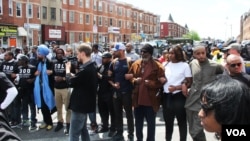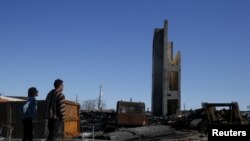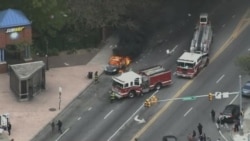The Baltimore police commissioner says the eastern U.S. "city is stable" as authorities enforce an overnight curfew a day after riots over the death of a young black man who died in police custody earlier this month
Police in riot gear confronted a small group of protesters who remained on the street in defiance of the curfew, which took effect at 10 p.m. local time. The crowd was gathered at an intersection in West Baltimore where the worst of the riots occurred Monday. When police ordered the crowd to disperse, some responded by throwing bottles and jeering at the police. But about an hour into the curfew, the protesters had largely left the area.
Television footage showed dozens of National Guard troops roaming the streets in military vehicles as the curfew took hold.
"The curfew, is, in fact, working," Police Commissioner Anthony Betts told reporters. "The biggest thing is that citizens are safe, the city is stable (and) we hope to maintain it that way." Betts said a total of 10 people were arrested after the curfew went into effect.
Through the day, city residents of all races came out to clean up, pick up and shed tears for burned-out stores and a looted shopping mall that included a supermarket and a top-name department store — essential services for one of the city's poorest neighborhoods
As the sun set Tuesday, streets that had been filled with rioters 24 hours earlier were instead filled with music, dancing and people hugging.
Mayor Stephanie Rawlings-Blake spent much of day visiting neighborhoods. She said she saw a lot of what Baltimore is about — people reclaiming and healing the city.
Some residents brought food and water to the police officers patrolling their streets. In the afternoon, outside a CVS pharmacy that looters had set ablaze Monday night, protesters sporadically clashed with police before civilians linked arms to form two parallel chains between the two groups.
Michael Coleman, a neighborhood resident, brought his two young children out to the rally. He said that while this month's death of the 25-year-old black man in police custody triggered the protests, the problem runs much wider than allegations of police brutality.
"This is more about power: economic power, social power," Coleman said.
"This is not a Baltimore thing or a race thing.... Race plays a part [in] it, but it's not the big picture."
Also Tuesday, U.S. President Barack Obama said there was "no excuse" for Monday night's violence in this eastern U.S. city, and the state's governor called in the National Guard and 2,000 volunteers "to maintain order and to repair the damage and violence from looting last night."
Riots had erupted in pockets of the city after Monday's funeral for Freddie Gray, who was arrested April 12, suffered spinal cord injuries and died a week later while still in police custody.
Distraction from 'legitimate concerns'
Obama said what happened Monday in Baltimore "distracted" from the multiple days of peaceful protests that were focused on what he described as "entirely legitimate concerns" over Gray's death.
"There's no excuse for the kind of violence that we saw yesterday," Obama said from the White House, making his first public statement about the Baltimore case. "It is counterproductive."
He added, "It's a handful of people taking advantage of a situation for their own purposes," and said they should be treated like criminals.
Maryland Governor Larry Hogan vowed Baltimore will not have "another repeat" of Monday night.
"It's not going to happen tonight," the governor told reporters Tuesday, saying he had temporarily relocated the state's capital to this city. He deployed the National Guard and mobilized more than 2,000 volunteers to help maintain calm and "begin the long process of restoring our community."
"We're going to make sure we get Baltimore back on track," Hogan said.
Monday's violence began as hundreds of high school students marched toward a local mall after classes were dismissed for the day, then spread out across several neighborhoods, overwhelming the police department's ability to respond as the protests turned violent.
Community policing
Obama acknowledged a "slow-rolling crisis" in community policing, saying there have been too many troubling police interactions with criminal suspects of color.
"We have seen too many instances of what appears to be police officers interacting with individuals – primarily African-American, often poor – in ways that raise troubling questions," the president said at a White House press conference with Japanese Prime Minister Shinzo Abe.
"I think there are police departments that have to do some soul-searching. I think there's some communities that have to do some soul-searching. I think we as a country have to do some soul-searching," he added.
"This is not new. It's been going on for decades," Obama added, referring to tensions in U.S. communities over police actions.
Obama described problems many communities struggle with equal opportunity, poverty, drugs, limited education, single parenting and lack of male figures at home. Too many people expect to "send the police to do the dirty work of containing the problems," he said.
He said solving them would require greater investment in police training, as well as early education and criminal justice reform.
Curfew imposed, schools closed
Rawlings-Blake, who called the rioting "one of the darkest days the city has ever faced," has declared a weeklong nighttime curfew from 10 p.m. to 5 a.m.
Public schools in the city of 620,000 people were closed Tuesday, as the city began to clean up after looters ransacked stores, pharmacies and a shopping mall and clashed with police.
Volunteers swept up charred debris in front of a CVS pharmacy as dozens of police officers in riot gear stood by and firefighters worked to damp down the embers.
Police news conference
At least 20 police officers have been injured as a result of violence in the city, according to Baltimore County Police Captain Eric Kowalczyk, who spoke at a Tuesday afternoon news conference.
He said there have been 144 vehicle fires, and one person is in critical condition due to a building fire that arsonists set during the rioting and looting.
Fifteen buildings, including a church-run senior center that was still under construction, and 144 vehicles were set on fire, and nearly 200 people were arrested, according to the city mayor's office Tuesday.
Protesters also threw rocks, bricks, bottles and other objects at riot police. Police Commissioner Anthony Batts said 15 officers were injured in the clashes, including six who were hospitalized.
Gray's family called for the rioting to stop late Monday night. "And I'm as hurt but I do not want you all to be out here," said Gloria Darden, Gray's mother. "I want you all to get justice for my son but don't do it like this here. Don't tear up the whole city, man. Just for him? It's wrong."
The attorney for Gray's family, Billy Murphy, said the family had hoped to organize a peace march later in the week.
WATCH: Related video report by Smita Nordwall
Initial response questioned
State and local authorities pledged to restore order and calm, but quickly found themselves responding to questions about whether their initial responses had been adequate.
Rawlings-Blake was asked why she waited hours to ask the governor to declare a state of emergency, while the governor himself hinted she should have come to him earlier.
"We were all in the command center in the second floor of the State House in constant communication, and we were trying to get in touch with the mayor for quite some time," Hogan, the governor, said at a Monday evening news conference. “She finally made that call, and we immediately took action."
Guard spokesman Lieutenant Charles Kohler said about 2,000 guardsmen were being deployed though the day and that the force could build to 5,000.
Kohler said it was the first time the National Guard was called in to quell unrest in Baltimore since 1968, when some of the same neighborhoods were convulsed by violence after the assassination of the Rev. Martin Luther King Jr.
Also, State Police said they were putting out a call for up to 500 additional law enforcement officers from Maryland and as many as 5,000 from around the mid-Atlantic region.
Latest incident of questionable police action
Gray suffered severe spinal cord injuries following his arrest on April 12.
Officials said he was not restrained properly while being transported in a police van. Police Commissioner Betts also said officers were slow to recognize that Gray, who apparently had asthma, needed medical attention.
Six officers who had contact with Gray have been placed on paid administrative leave.
The rioting Monday was the worst such violence in the U.S. since the turbulent protests that broke out over the death of Michael Brown, the unarmed black 18-year-old who was shot by a white police officer in Ferguson, Missouri, last summer.
New attorney general condemns violence
U.S. Attorney General Loretta Lynch, who was sworn in Monday just hours before the violence erupted, met with Obama at the White House to discuss the federal government's response to the unrest.
Lynch later issued a statement condemning what she called "the senseless acts of violence by some individuals in Baltimore." She promised to deploy the full resources of the Justice Department in "protecting those under threat, investigating wrongdoing, and securing an end to violence."
The Justice Department and the FBI have a civil rights investigation into Gray's death. The Baltimore Police Department said more information on the case is expected Friday.
Baltimore is located about 60 kilometers, or 40 miles, northeast of Washington, D.C.
Some material for this report came from The Associated Press, AFP and Reuters.










